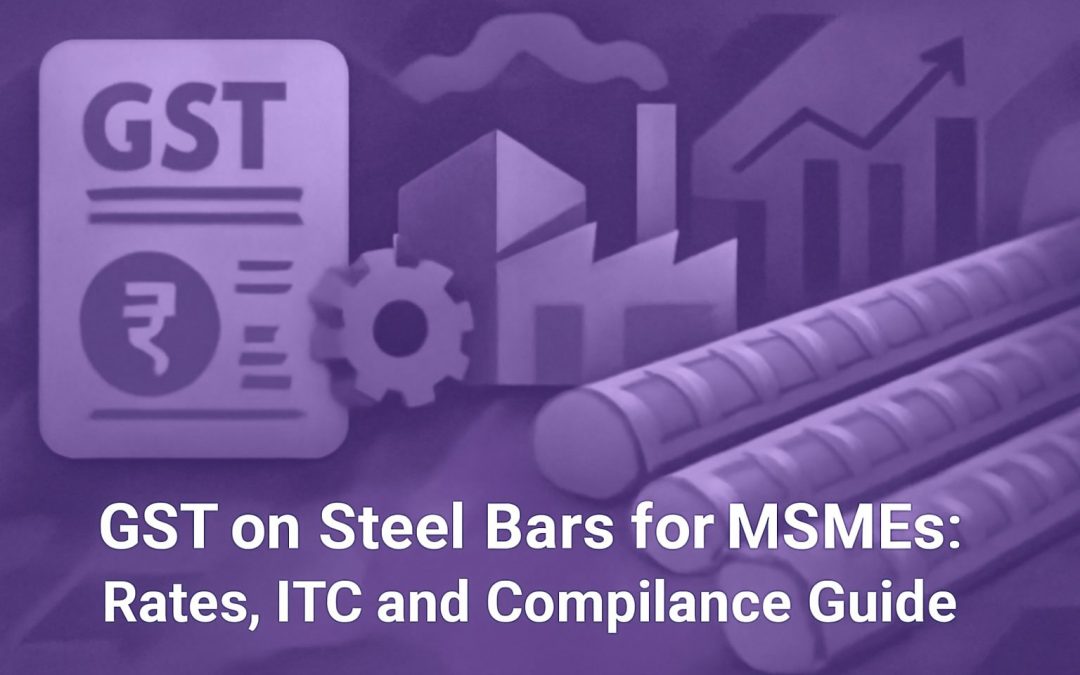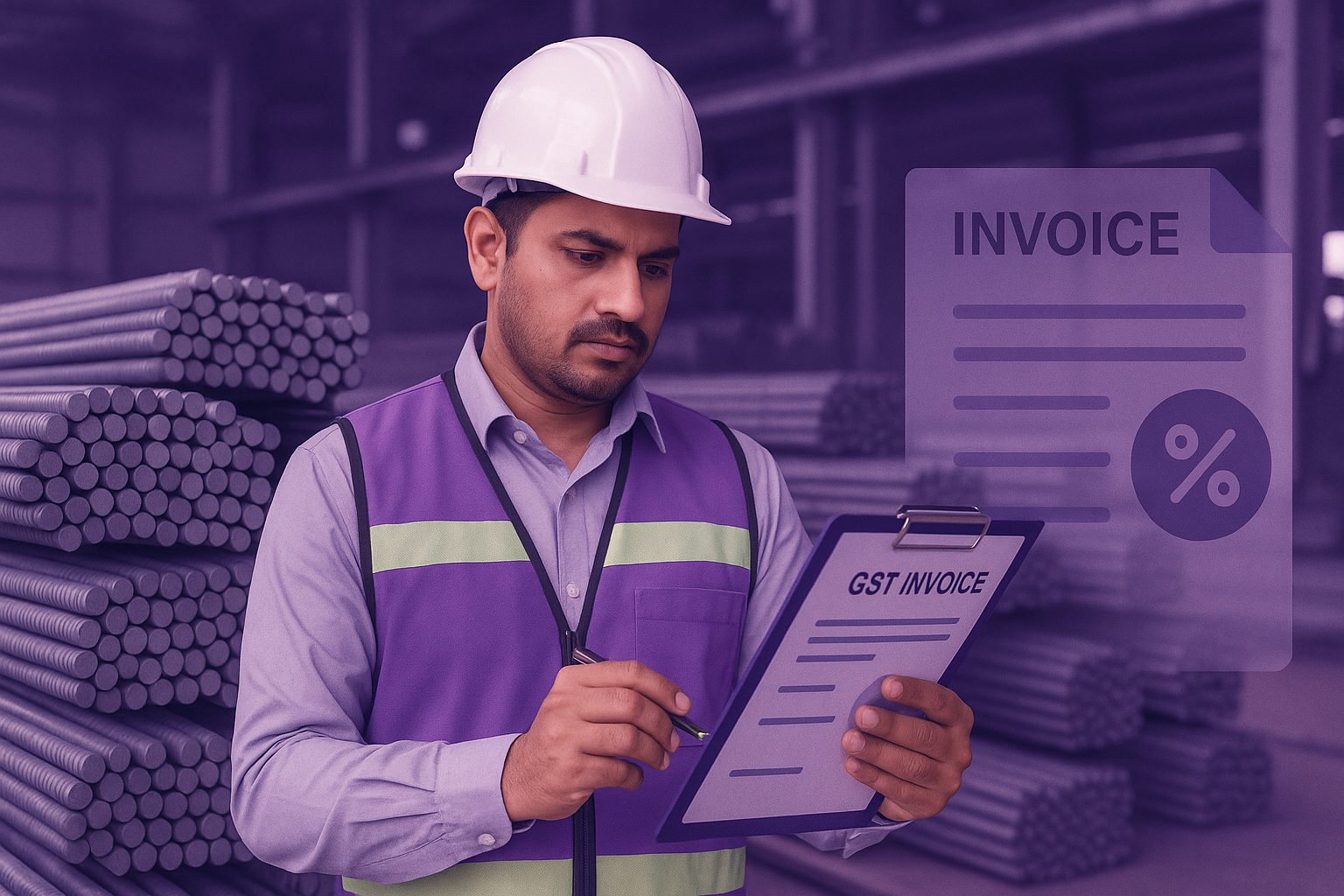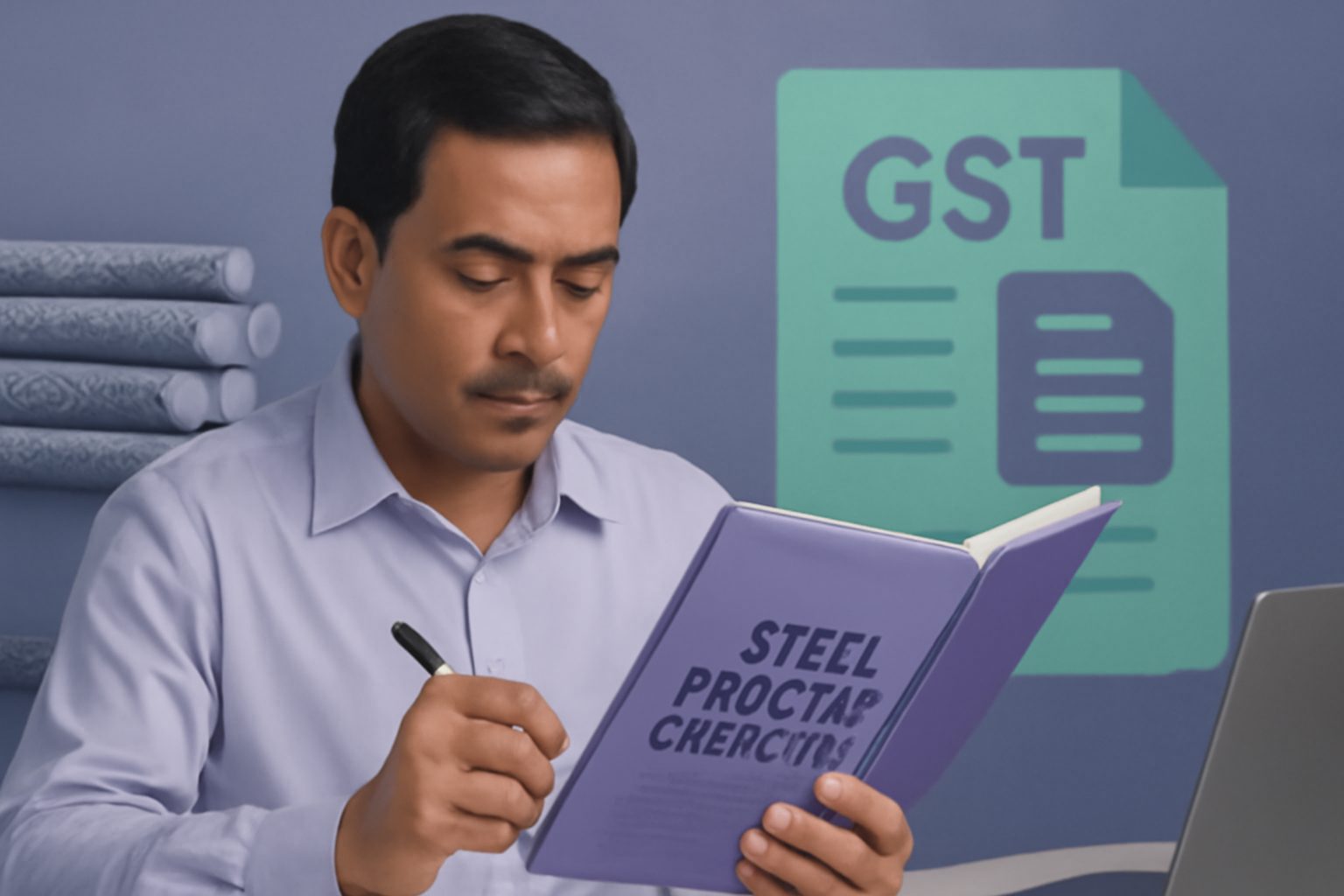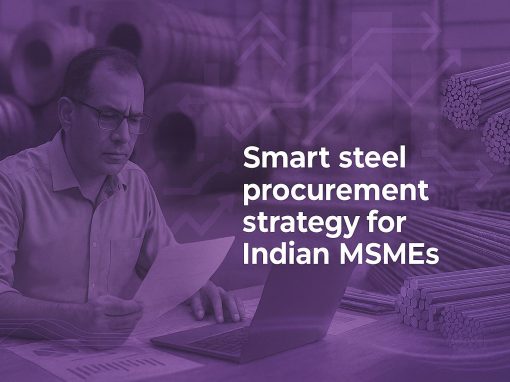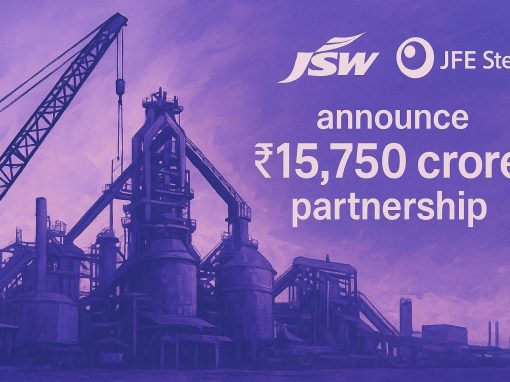Table of Contents
- Introduction
- GST rates on steel products
- GST on steel bars
- ITC rules MSMEs must know
- Interstate vs Intrastate GST implications
- Freight and transportation costs under GST
- Job work, cutting and scrap handling
- HSN codes and compliance in GST filing
- Importance of HSN code
- Procurement paperwork and tender clauses
- Conclusion
- FAQs
Introduction
Steel bars are a core input in construction, fabrication, and many MSME industries. These are repeat purchases, not one-time buys. The tax rate applied on every order affects working capital, delivery cost, and contract pricing. A wrong entry in invoices or tender documents can block Input Tax Credit (ITC) and reduce margins. The current applicable GST (Goods and Services Tax) rate for steel bars fall under HSN 7214 is 18%. While this looks like simple, the practical impact is linked with freight charges, e-invoicing thresholds, credit rules, etc. that businesses cannot afford to ignore.
Why MSMEs must pay attention
- ITC rules decide if GST paid on steel can be claimed back.
- Tender clauses may fail if GST conditions are vague.
- Freight taxation alters the landed cost of every truckload.
- E-way bills and shortage notes create risk if not handled correctly.
Here in this guide, we will discuss GST on steel bars with CBIC-backed references. Apart from it, we cover compliance rules, practical problems, and steps small and medium-sized businesses should follow. It will support MSMEs to keep procurement efficient and audit-ready.
Also read: GST advantages and disadvantages for SMEs
GST rates on steel products
Have a look at the GST rates of steel products as published by the Central Board of Indirect Taxes and Customs (CBIC) along with their HSN code:
Also read: How to calculate GST with GST calculator
| HSN code | Steel products | CGST Rate | SGST/UTGST Rate | IGST Rate |
| 7204 | Ferrous waste and scrap; remelting scrap
ingots of iron or steel |
9% | 9% | 18% |
| 7205 | Granules and powders, of pig iron, spiegeleisen, iron or steel | 9% | 9% | 18% |
| 7206
|
Iron and non-alloy steel in ingots or other primary forms (excluding iron of heading
7203) |
9% | 9% | 18% |
| 7207
|
Semi-finished products of iron or non-
alloy steel |
9% | 9% | 18% |
| 7208 to 7212
|
All flat-rolled products of iron or non-
alloy steel |
9% | 9% | 18% |
| 7213 to 7215
|
All bars and rods, of iron or non-alloy steel | 9% | 9% | 18% |
| 7216 | Angles, shapes and sections of iron or non- | 9% | 9% | 18% |
| 7217 | Wire of iron or non-alloy steel | 9% | 9% | 18% |
| 7218 | Stainless steel in ingots or other primary forms; semi-finished products of stainless
steel |
9% | 9% | 18% |
| 7219, 7220 | All flat-rolled products of stainless steel | 9% | 9% | 18% |
| 7221, 7222 | All bars and rods, of stainless steel | 9% | 9% | 18% |
| 7223 | Wire of stainless steel | 9% | 9% | 18% |
| 7224 | Other alloy steel in ingots or other primary forms; semi-finished products of other
alloy steel |
9% | 9% | 18% |
| 7225, 7226 | All flat-rolled products of other alloy steel | 9% | 9% | 18% |
| 7227, 7228 | All bars and rods of other alloy steel | 9% | 9% | 18% |
| 7229 | Wire of other alloy steel | 9% | 9% | 18% |
| 7301 | Sheet piling of iron or steel, whether or not drilled, punched or made from assembled elements; welded angles, shapes and
sections, of iron or steel |
9% | 9% | 18% |
| 7302 | Railway or tramway track construction material of iron or steel, the following: rails, checkrails and rack rails, switch blades, crossing frogs, point rods and other crossing pieces, sleepers (crossties), fish- plates, chairs, chair wedges, sole plates (base plates), rail clips bedplates, ties and other material specialised for jointing or fixing rails | 9% | 9% | 18% |
| 7304 | Tubes, pipes and hollow profiles, seamless, of iron (other than cast iron) or
steel |
9% | 9% | 18% |
| 7305 | Other tubes and pipes (for example, welded, riveted or similarly closed), having circular cross‑sections, the external diameter of whichexceeds 406.4 mm, of iron or steel | 9% | 9% | 18% |
| 7306 | Other tubes, pipes and hollow profiles (for example, open seam or welded, riveted or similarly closed), of iron or steel | 9% | 9% | 18% |
| 7307 | Tube or pipe fittings (for example,
couplings, elbows, sleeves), of iron or steel |
9% | 9% | 18% |
| 7318 | Screws, bolts, nuts, coach screws, screw hooks, rivets, cotters, cotter-pins, washers (including spring washers) and similar
articles, of iron or steel |
9% | 9% | 18% |
Also read: What are the tax benefits on a business loan?
For a full list of GST rates on steel items please visit the CBIC website.
From the above table you can note that all the steel products come under the GST bracket of 18%. State and the central government tax for steel products is 9% each.
Given below is an explanation of the terms given in the table above for better understanding:
- CGST
CGST is Central Goods and Services Tax and is a tax levied on intrastate supplies of goods and services by the Central Government.
- SGST
SGST is State Goods and Services Tax which is the tax to be given to the state government. Under GST, SGST is collected on intrastate supplies of goods and services and the SGST tax rate is equal to CGST tax rate collected. This is collected along with CGST.
- UTGST
UTGST stands for the Union Territory Goods and Services Tax. It is the goods and services tax levied by the governments in Union Territories. Union Territories of Delhi and Puducherry fall under SGST law as they have their own legislature.
- IGST
IGST is Integrated Goods and Services Tax, levied on all interstate supplies of goods and/or services. It is applicable to imports and exports.
GST on steel bars
If you look at the table above you can see three different types of steel bars mentioned:
- All bars and rods of iron or non-alloy steel (Also read: Iron rod – Prices, uses, type)
- All bars and rods of stainless steel
- All bars and rods of other alloy steel
In the GST rate schedule, steel bars are placed under HSN codes 7213, 7214 and 7215. These codes cover plain bars, rods of non-alloy steel, stainless steel, and alloy grades. All fall under the 18 per cent slab.
The government’s idea was to keep one clear rate across categories. That decision has reduced confusion in billing, though it leaves no room for rate variation that MSMEs once expected when dealing with different grades of steel.
Rate structure in use
In practice, the same rule applies everywhere. If the supply is within a state, the invoice shows CGST and SGST, each at 9 percent. If the bars move across state lines, IGST at 18 percent is charged.
This design keeps taxation neutral for the buyer. For an MSME, the real concern is not the rate itself, but whether the input tax credit flows back without delay. That is where mistakes in HSN codes or misclassification can cost money.
Products most relevant to MSMEs
Although the GST chart lists several categories, MSMEs work mainly with three:
- TMT bars, essential in construction and infrastructure.
- Mild steel rods, for fabrication and general workshops.
- Stainless and alloy bars, used where strength and corrosion resistance are critical.
All are taxed at the same 18 per cent GST. The uniform rate allows buyers to plan tender pricing and procurement budgets with certainty.
Why the rate matters
The number itself may seem routine. Yet, in a live procurement cycle, it decides whether a tender is priced correctly, whether a distributor avoids dispute at delivery, and whether a manufacturer can claim ITC without questions from the tax officer.
For MSMEs, GST on steel bars is not a static figure in the CBIC chart. It is a constant input in cost sheets, purchase orders, and bid submissions. A misstep here can block credit, squeeze margins, and disturb cash flow.
ITC rules MSMEs must know
Steel procurement is not only about paying GST at the correct rate. What matters for MSMEs is whether the tax paid can be claimed back through Input Tax Credit (ITC). This single factor decides if GST is a pass-through or a real cost. Many small businesses lose money simply because they misread ITC eligibility or fail to document usage correctly.
When ITC is allowed
ITC can be claimed when steel bars are used as raw material or as part of plant and machinery. For example:
- A fabrication unit cutting bars into structural frames.
- A manufacturer using bars in equipment or finished goods.
Here, the GST paid on purchase reduces the tax liability on output. For MSMEs, this creates breathing space in cash flow and lowers the risk of double taxation.
When ITC is blocked
Under Section 17(5) of the GST Act, credit is denied if steel is used in constructing civil structures. A new factory shed, office block, or warehouse built with TMT bars will not qualify for ITC. The tax becomes a sunk expense. Many firms claim it wrongly and later face penalties or blocked refunds.
Grey areas and exceptions
The line between plant and building is not always clear. Steel used in machinery foundations may qualify, but the same steel used in flooring or walls does not. The difference lies in how the asset is classified. Strong documentation – invoices, project reports, and usage notes – is the only way to defend a claim if questioned.
Why it matters for MSMEs
For a small unit, a blocked credit of even a few lakhs can dry up working capital. Misuse of ITC also hurts credibility. It reflects poorly in GST returns and can reduce confidence among suppliers, buyers, and banks. Clean ITC records protect margins and open doors for easier tender approvals and financing.
Interstate vs Intrastate GST implications
Steel does not stay within city limits. Orders often move across state lines, either for projects or for distributor supply. The GST law treats these two movements differently, even though the rate on steel bars is fixed at 18 percent. For an MSME buyer, this split influences how invoices are raised, how returns are filed, and how credit flows back.
Supplies within a state
When the seller and buyer are in the same state, GST is divided between the Centre and the State. An invoice shows 9 percent CGST and 9 percent SGST. For example, a workshop in Pune buying from a supplier in Nagpur falls under this category. The ITC can be claimed as long as the invoice is matched in filings.
Supplies scross states
If the material crosses a border, the tax appears differently. The supplier charges 18 percent IGST. Say a distributor in Gujarat sells to a contractor in Rajasthan. The buyer pays IGST, and later claims the full amount as ITC. This mechanism ensures there is no double taxation as goods move from one state to another.
Why MSMEs must pay attention
On paper, the total tax is the same. In practice, the reporting codes differ. Small firms often misclassify interstate supplies as intrastate, or vice versa. That error shows up as a mismatch in GSTR filings. The result: delayed credit and strained working capital. In government tenders, quoting the wrong tax structure can also get a bid disqualified.
Freight and transportation costs under GST
To move steel, it may be, within the city or state, is never cheap. Bars and rods are heavy, bulky, and often shipped in full truckloads. For MSMEs, the freight bill is a significant part of the landed price. The way GST applies on this freight is just as important as the tax on the steel itself. Get it wrong, and margins shrink before the material even reaches the yard.
Reverse charge vs Forward charge
Most steel is transported through Goods Transport Agencies (GTAs). Here GST can be handled in two ways.
- Under reverse charge, the transporter issues a bill without GST. The buyer pays 5 percent tax directly to the government and then claims credit.
- Under forward charge, the transporter adds 12 percent GST on the freight bill. The supplier remits it, and the buyer can claim ITC from the invoice.
The choice affects cash flow. Reverse charge means paying first and adjusting later. Forward charge passes the responsibility to the transporter but comes with a higher tax rate.
Effect on landed cost
On a small consignment, the difference may look minor. On a 20-tonne truckload, it becomes serious. A few percentage points on freight can alter the total delivered cost. MSMEs quoting for tenders often forget to adjust for this, and the result is under-quoted bids or unexpected losses.
Paperwork discipline
Transport invoices, e-way bills, and GST returns must all match the method chosen. A reverse charge entry wrongly shown as forward charge is a common audit red flag. For smaller firms, such errors don’t just delay ITC – they tie up working capital when it is needed most.
Job work, cutting and scrap handling
In steel supply, very little is used in the same form it is purchased. Bars are usually cut, bent, or customised before they go into a project. MSMEs rely heavily on local job workers for this. The challenge is not in the work itself but in how GST treats the movement of material and the scrap that follows.
Tax on job work
When bars are sent to a job worker, GST is not charged on the transfer. It moves under a delivery challan. Once the service is finished, the job worker raises an invoice for cutting or bending. That invoice attracts GST, usually at 18 percent. The MSME can claim ITC on this charge, but only if the return flow of goods is properly recorded.
Scrap management
Scrap is unavoidable in rebar cutting. Off-cuts pile up at the job worker’s premises. There are two ways this is handled:
- The scrap is returned along with the finished bars. The MSME later sells it and pays tax.
- The scrap is sold by the job worker directly. In this case, the sale has to be billed in the name of the MSME, not in the worker’s own books.
Without this control, scrap sales often become a compliance gap that tax officers flag during audits.
Paperwork discipline
Section 143 of the GST law allows raw material to move out for job work without immediate tax. But it also expects records of issue and return. Many small firms miss out on updating challans or mixing up invoices. The result is blocked credit or notices for unaccounted scrap.
Why MSMEs must be careful
Job work is part of everyday steel procurement. Yet, in audits, it is also one of the first areas checked. Poor record keeping can turn a routine cutting job into a tax dispute. Clean documentation – challans, invoices, scrap records – ensures that steel procurement cycles remain smooth and credit remains available.
HSN codes and compliance in GST filing
Every steel invoice must carry the right code. Under GST, that code is the HSN – Harmonised System of Nomenclature. For MSMEs, it is not just paperwork. It is the anchor that connects supplies with GST returns and with ITC claims.
Why it matters
Take steel bars. The recognised code is 7214. If an invoice carries a wrong code – say a generic iron entry instead of rebar – the system may not accept the ITC. At audit, it can even be treated as misreporting. The rate may be the same, but the error can still block credit.
Rules by turnover
GST law sets thresholds:
- Below ₹1.5 crore: HSN is optional.
- ₹1.5–5 crore: two-digit code is required.
- Above ₹5 crore: full six-digit HSN must be shown.
Most mid-sized MSMEs are in the second or third category. Missing the code or punching it incorrectly is enough to draw a notice.
Common gaps seen in practice
Many businesses simply copy codes from past invoices. Others leave it to clerks, who may not know the difference between flat products and bars. In tenders, wrong HSN coding often leads to bid rejection, even when the price quoted is right.
Lesson for MSMEs
The HSN is not a formality. It is the number that protects tax credit, keeps filings clean, and gives confidence to both buyers and auditors. For an MSME, getting this small detail wrong can mean losing working capital or missing a contract.
Importance of HSN code
The full form of HSN is Harmonised System of Nomenclature code. This is a 6-digit code that classifies various products. Manufacturers and suppliers indicate HSN code on their tax invoices and exporters and importers mention these codes in their import and export documents. We have covered a blog on the HSN code for ferrous waste and scrap for better understanding.
HSN classification is used for tax purposes to identify the rate of tax applicable to a specific product. This makes GST filing easy for businesses as a code for products eliminates the need of entering details of the products.
Businesses with a turnover of less than ₹1.5 Crore do not need to adopt HSN codes for their commodities. Companies with turnover between ₹1.5 crore and ₹5 Crore use two-digit HSN codes for their commodities.
If you are looking for business growth opportunities do visit Tata nexarc. We provide instant business loans, logistics services, etc., tailored to the needs of small businesses. We can even help you find suitable tenders and help you win them.
Also read: Tax benefits and incentives for MSMEs in India
Procurement paperwork and tender clauses
For MSMEs, the real test of GST is not only the rate. It is in the paperwork. A single missing field on an invoice or a vague clause in a purchase order can block ITC or stall payment. In government contracts, it may even get a bid thrown out.
E-invoicing and e-way bills
Suppliers crossing the turnover threshold must issue e-invoices. Without the IRN (Invoice Reference Number) from the portal, the document is invalid for credit. Buyers relying on such invoices end up losing ITC until the error is fixed.
Steel consignments also need an e-way bill when moved in bulk. Inspectors at tolls and weighbridges usually ask for this first. If the document is missing or does not match the truck details, penalties follow and deliveries get delayed.
Shortages and credit notes
Short delivery is common with steel. A few bars less after unloading, or a weight mismatch at the yard, is enough to upset accounts. The only safe fix is a credit note from the supplier. Many small firms adjust informally with transporters or deduct cash, but that leaves GST returns mismatched. During audit, such gaps are flagged quickly.
Tender and contract language
Public buyers expect clarity on GST in tenders. If slabs change during the contract period, the bidder needs a variation clause in place. Larger companies already build this safeguard. MSMEs often skip it, and when tax rates shift, the extra burden lands on them. Anti-profiteering rules also demand that any reduction in GST be passed on. Without a clear clause, this becomes a dispute point later.
Why discipline pays
These may look like clerical points, but they decide whether working capital stays free or gets stuck. For MSMEs, discipline in invoices, e-way bills, and tender wording is not red tape. It is a business survival tool.
Conclusion
For steel bars, the GST rate may be fixed at 18 percent. But for MSMEs, the story is not that simple. The way the tax is billed, reported, and claimed decides whether cash flow stays healthy or gets stuck.
The key is discipline. Use the right HSN code. Match every invoice with an e-invoice or e-way bill when required. Record shortages with proper credit notes instead of informal adjustments. Keep a paper trail for job work and scrap. And in tenders, spell out how GST changes will be handled – leaving it vague often costs the bidder.
These are not clerical points. They decide whether ITC comes on time, whether payments are cleared, and whether a contract remains profitable. Small firms that treat GST compliance as part of routine procurement find fewer disputes and smoother audits. Those that cut corners usually lose margins to blocked credit or penalties.
For MSMEs, GST on steel bars is not just a tax entry. It is a lever to protect working capital, build supplier trust, and stay competitive in government and private projects alike.
Looking to procure steel?
Tata nexarc helps manufacturers, builders and MSMEs source certified steel products, compare prices, and choose the right grade as per IS codes—with complete traceability and procurement confidence.
FAQs
How should GST be shown in GeM or tender bids?
Are advances to steel suppliers covered under GST?
Can GST on freight under reverse charge be claimed back?
What if invoices are raised without HSN codes?
Is ITC available on imported steel bars?
How to manage GST on rejected consignments?
Does scrap from cutting steel attract GST?
What happens if the wrong HSN code is used?
Can ITC from steel purchases be adjusted against service GST?
How is GST handled for steel on a consignment basis?
Can MSMEs trade in steel under the GST composition scheme?
Are e-invoices compulsory for every steel supplier?
Charul is a content marketing professional and seasoned content writer who loves writing on various topics with 3 years of experience. At Tata nexarc, it has been 2 years since she is helping business to understand jargon better and deeper to make strategical decisions. While not writing, she loves listing pop music.
